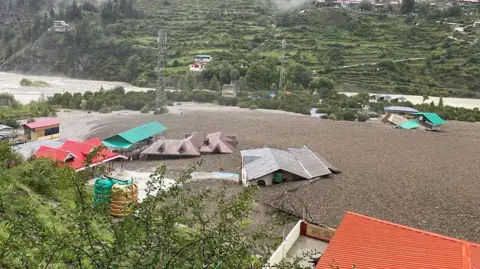In recent news from India, the northern state of Uttarakhand has been grappling with the aftermath of devastating flash floods that struck on August 5, 2025. As the situation unfolds, authorities have reported that at least 66 individuals remain missing, creating a grim sense of urgency in rescue operations. The floods, which were triggered by heavy rainfall and a significant mudslide in the village of Dharali, have caused extensive destruction, submerging homes and transforming the landscape.
According to official statements, only one body has been recovered so far, marking a tragic revision of earlier estimates that suggested the death toll could be higher. The disaster has particularly affected Dharali village, where nearly half the area was inundated by torrents of muddy water and debris. Alongside civilian impacts, an army camp nearby also suffered major damage, amplifying the scope of the crisis. With ongoing rescue operations hampered by inclement weather and the critical blockage of highways due to mudslides, efforts to locate the missing individuals are facing significant challenges.
The relentless rains that have pounded Uttarakhand for weeks have significantly worsened conditions, with the Uttarkashi region being highlighted as one of the worst hit. Since the onset of the floods, officials estimate that around 1,300 people have been rescued from the surrounding areas, yet that number does little to soften the blow of loss and uncertainty felt by families of the missing. Eyewitness accounts and videos circulating online depict a harrowing scene, with waves of muddy water ruthlessly sweeping through streets, demolishing structures, and leaving residents with little time to escape.
Initial assessments by local officials, including Uttarakhand’s chief minister, pointed to a cloudburst as the catalyst for these destructive floods; however, this has yet to be confirmed by the Indian Meteorological Department. Senior local official Vinay Shankar Pandey mentioned that a dedicated team of ten geologists has been dispatched to the impacted area to evaluate the cause of the disaster more precisely. This detail underscores the gravity of the situation and the need for thorough investigation and understanding before future preventative measures can be enforced.
One of the most pressing concerns posed by the floods is the creation of an artificial lake caused by the blockage of the Bhagirathi River, a crucial waterway in the region. The sludge from the overflowing Kheerganga River has compounded the issues, which has in turn submerged significant tracts of land, including a helipad earmarked for rescue efforts. As rescue workers strive to drain this lake, further rainfall has complicated their endeavors, thwarting efforts made to contain the disaster’s impact.
Mr. Pandey reported that amongst those listed as missing are 24 Nepalese workers, 14 local residents, and several army personnel, emphasizing the widespread effect of the disaster. Despite official lists, locals contend that the actual number of missing individuals may be even higher, amplifying the fears and frustrations of the community.
The physical aspects of the rescue efforts are equally intense, as officials employ helicopters to access hard-hit areas like Dharali, still obstructed by debris. Temporary bridges have been constructed to facilitate the evacuation of people and supplies, and workers, including volunteers, labor tirelessly to clear the roads and resume some semblance of normalcy.
The overarching sense of urgency in these operations is palpable as rescuers utilize sniffer dogs and heavy machinery to locate individuals trapped under rubble. Eyewitness accounts describe the painstaking work of rescuers who are manually digging through the remnants of buildings where businesses and homes once stood. Unfortunately, while they focus on immediate recovery, the forecast continues to predict heavy rains and thunderstorms for the district, which could lead to further complications in both rescue and recovery efforts.
As the people of Uttarakhand grapple with these tragic events and the uncertainty of what lies ahead, the situation remains fluid. Overall, the ongoing efforts by government officials and local communities alike illustrate not just the physical toll of natural disasters but also the resilience and spirit of the people as they navigate through this challenging period.











